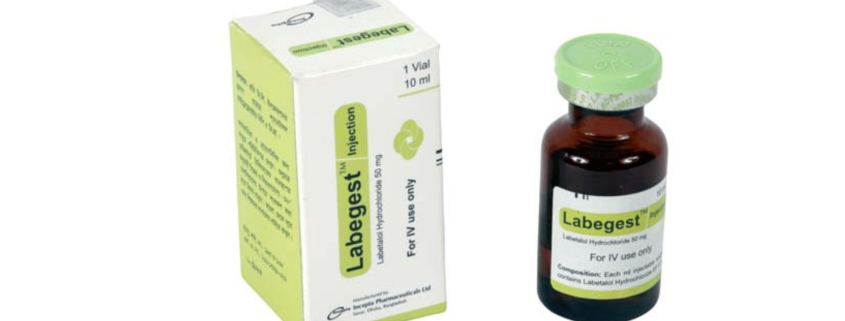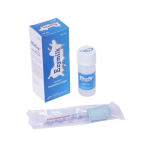Labegest Injection(Labetalol Hydrochloride)

Therapeutic Group: Beta Blocker
Presentation
Labegest Injection: Each ml injectable solution contains Labetalol Hydrochloride BP 5 mg.
Description
Labetalol Hydrochloride is an adrenergic receptor blocking agents that have both selective alpha1-adrenergic and nonselective beta adrenergic receptor blocking actions. Both the alpha- and beta-blocking actions of orally administered Labetalol Hydrochloride contribute to a decrease in blood pressure in hypertensive patients. In man, the ratios of alpha- to beta-blockade have been estimated to be approximately 1:3 and 1:7 following oral and IV administration, respectively
Indications
Labetalol Hydrochloride indicated for control of blood pressure in severe hypertension.
Dosage & Administration
Labetalol Injection is intended for IV use. Either of two methods of administration of Labetalol Injection may be used: a) repeated IV injection, or b) slow continuous infusion.
Repeated IV Injection: Initially, Labetalol Injection should be given in a 20-mg dose (which corresponds to 0.25 mg/kg for an 80-kg patient) by slow IV injection over a 2-minute period. Immediately before the injection and at 5 and 10 minutes after injection, supine blood pressure should be measured to evaluate response. Additional injections of 40 or 80 mg can be given at 10-minute intervals until a desired supine blood pressure is achieved or a total of 300 mg of Labetalol Hydrochloride has been injected. The maximum effect usually occurs within 5 minutes of each injection.
Slow Continuous Infusion: Labetalol Injection is prepared for continuous IV infusion by diluting the vial contents with commonly used IV fluids. Examples of two methods of
preparing the infusion solution are:
Add 40 mL of Labetalol Injection to 160 mL of a commonly used IV fluid such that the resultant 200 mL of solution contains 200 mg of Labetalol Hydrochloride, 1 mg/ml. The
diluted solution should be administered at a rate of 2 mL /min to deliver 2 mg/min.
Alternatively, add 40 mL of Labetalol Injection to 250 mL of a commonly used IV fluid. The resultant solution will contain 200 mg of Labetalol Hydrochloride, approximately 2 mg/3 ml. The diluted solution should be administered at a rate of 3 ml /min to deliver approximately 2 mg/min.
Side Effects
Most side effects are mild and transient and occur early in the course of treatment. These include ventricular arrhythmia, dizziness, tingling of the scalp/skin, hypoesthesia (numbness), vertigo, transient increase in blood urea nitrogen and serum creatinine levels,
nausea, vomiting, dyspepsia, taste distortion, somnolence/yawning, wheezing, rash, urticaria, pruritus, angioedema, dyspnea, hypotension, and rarely, syncope, bradycardia, heart block, hepatic necrosis, hepatitis, cholestatic jaundice, elevated liver function, anaphylactoid reactions.
Precautions
Labetalol Hydrochloride should be used with caution in patients with Impaired Hepatic Function, Congestive Heart Failure, Exacerbation of Ischemic Heart Disease, Non-allergic Bronchospasm, Pheochromocytoma, Diabetes Mellitus and Hypoglycemia.
Use in Pregnancy & Lactation
Pregnancy: Pregnancy Category C. Teratogenic studies were performed with Labetalol in rats and rabbits at oral doses up to approximately six and four times the maximum
recommended human dose (MRHD), respectively. No reproducible evidence of fetal malformations was observed. Labetalol Hydrochloride given to pregnant women with
hypertension did not appear to affect the usual course of labor and delivery.
Lactation: Small amounts of Labetalol (approximately 0.004% of the maternal dose) are excreted in human milk. Caution should be exercised when Labetalol tablets are
administered to a nursing woman.
Use in Children
Safety and effectiveness in children have not been established
Drug Interaction
Labetalol Hydrochloride in combination with tricyclic antidepressants may cause tremor; Cimetidine has been shown to increase the bioavailability of Labetalol Hydrochloride. If Labetalol Hydrochloride is used with nitroglycerin in patients with angina pectoris, additional antihypertensive effects may occur; Care should be taken if Labetalol is used concomitantly with calcium antagonists of the verapamil type; Both digitalis glycosides and beta-blockers slow atrioventricular conduction and decrease heart rate. Concomitant use can increase the risk of bradycardia.
Over Dose
Overdosage with Labetalol Hydrochloride causes excessive hypotension and sometimes, excessive bradycardia. The following additional measures should be employed if necessary:
Excessive bradycardia-administer atropine or epinephrine; Cardiac failure-administer a digitalis glycoside and a diuretic; Hypotension-administer vasopressors, e.g.,
norepinephrine; Bronchospasm-administer epinephrine and/or an aerosolized beta2-agonist; Seizures-administer diazepam.
In severe beta-blocker overdose resulting in hypotension and/or bradycardia, glucagon has been shown to be effective when administered in large doses (5 to 10 mg rapidly over 30 seconds, followed by continuous infusion of 5 mg per hour that can be reduced as the patient improves).
Storage
Do not store above 300 C. Keep away from light and out of the reach of children.
Commercial Pack
Labegest Injection: Each box contains 1 vial of 10 ml injection.



